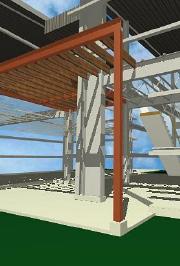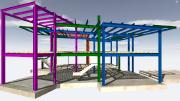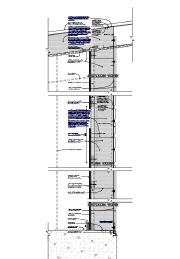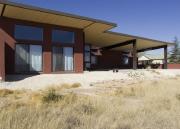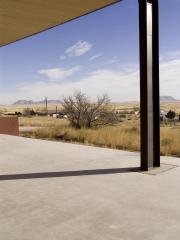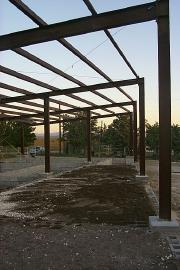Current
Practice,
2010: Big Change
Cameron
Armstrong
These writings are footnotes to current work, and a snapshot of critical issues. 2009-2010 was marked by many themes of the early 2000's - such as increasing prefabrication, emerging parallels with other professional practices, and new ways to comprehend the multiple interests bearing on our projects (see 2008: Many Voices). Intellectual currents continue to be stirred by practical lessons.
1. Ideas are Technology
Advances in software and prefabrication, together with new approaches to client engagement mean that the emergence of a design now seamlessly overlaps its documentation and production. Unconstrained by a lockstep path from inspiration to result, ideas instead remain open for assessment and revision, right through construction. With "fly-through" visualization available any time and anywhere via web site downloads, parties easily gain the knowledge to participate at all scales of decision. Drawings are derived and transmitted almost instantly from a shared, evolving 3D model. Parallel flows of this information, and the archival function of the internet assure a self aware, historically-grounded human context for new developments. A concept's embodiment in modeled form means that its formal definition - its completion as an idea per se - now also marks its arrival as a detailed virtual object. It is well-documented, by definition, and often immediately ready for fabrication and the building site. Sometimes, all that remains is to schedule factory time.
In the past, building projects were marked by an urgent need for top down control. Their complexity has always reflected the massive scale of social, cultural and financial investment they required. During the 20th Century, new materials, techniques, and ambitions so multiplied this complexity that not just long practice with blueprints, but a genius level three-dimensional mind was needed to understand decisions, and act on them. Success demanded that power over design be narrowly held. Meanwhile, designers and clients alike suffered from barriers to communication that rendered their respective expertise in space and construction, and in the project's specific requirements mutually opaque. Architects based their work on guesses, and clients learned about their buildings after the fact. By contrast, design in the 21st Century is characterised by transparency, quick revision, and the potential for direct involvement by virtually every significant player. The contributions of engineers, architects, users, and manufacturers can be seamlessly incorporated without unraveling the process. It proceeds by broad consensus rather than visionary autocracy, through well-informed real time interactions.
Therefore, the relationship between ideas and buildings has changed. Instead of formation through a theoretical process much removed from material realities, ideas can evolve in direct engagement with objective conditions - cultural and personal, as well as physical and economic. Rapid prototyping and other streamlined trial-and-error methods have made knocking the rough edges off emergent solutions fast and efficient. Construction schedules have moved beyond guesswork about labor, materials, and weather, to coordinating the delivery and assembly of pre-fabricated systems. Kit built, major building elements come together in weeks rather than months. The creativity of improvisation is channeled to fulfilling harmonies discovered as a project unfolds, rather than to warding off chaos.These breakthroughs have rendered obsolete the notion of architectural meanings as matters primarily of linguistic signification, and ended reliance upon linear decision-making. Although the relations between ideas and new, physical facts will never be "automatic" - there'll never be a simple, redundant protocol for making blueprints, or a building - few gaps remain between intention, concept and realization. Thinking an idea while modeling it and its physical installation has created a close integration of objects with their motivations.
This movement implies more than just a tighter, more efficient linkage of ideas to outcomes. The recurring, multi-voiced critique made possible by broad access to information, and the ease of changing virtual models has transformed the process of revising design into a recurring chance to connect with basic priorities. As a result, the critical impulses of architectural programming have driven deep into the design process, pushing to derive buildings' gestural performances from the unfolding discovery of clients' existential necessities. Emerging directly from this transparency of needs, desires and context, design ideas no longer merely inspire or represent. With digital technology, thought and manufacture have become indistinguishable. Their virtual, tandem unfolding within each project is the operation of a revolutionary new machinery for achieving architectural tasks. The power of this technology to realize the fundamental gestures of human institutions poses, with each project, a confrontation with the question of our work's ultimate direction.
2. Parallel Paths
Analyzing how part of a wall blocks heat, while another part bridges it directly into a building; estimating the time needed for a computer to process a complex visualization; diagramming how a roof can transform large air movements into gently cooling breezes in particular places at particular times; managing the evolution of decisions based on multiple views, whose consensus depends upon synchronized comprehension of what is at stake, and where the benefits go - all these aspects of design work, and more, are subject to parallel flows of energy and information. Our solutions - whether of a structural frame, a temperature gradient, or of how a kitchen will function - are creatures of simultaneous, multi-pathed and strongly inter-connected sets of interactions.
At a larger scale, this rule also applies to the systems we rely upon for physical construction. Something as simple and local as a small, stupid dimensional error in a foundation's layout can cause a massive disruption in a building's physical assembly, its schedule and its budget. Construction systems requiring close top-down direction and perfect execution, and whose flexibility is limited to internally-generated solutions, are doomed to be used only rarely or to produce chaos - a paradox because order should be their chief benefit. For wide adoption, a system must be able to readily incorporate other, often alien techniques. This is a matter of history: wooden buildings are often hybridized with steel, steel with concrete, concrete with steel and wood, etc., which explains why our world is built of them, and not of Structural Insulated Panels (SIPs). Openness to improvisation, whether in design or on the job site, is a critical determinant of success.
For us, understanding the ubiquity and importance of parallel paths has been both an endorsement of our open practice approach, and a reminder that no one actor is ever truly in control. This moment, in this place, was produced by a million converging paths. We are its stewards, not its masters.
3. A New Way of Living with the Animals
Human awareness is so burdened by economic and aesthetic concerns that we rarely stop to see Nature as it is, in itself. We quickly gloss over what we share with its creatures, unless basic truths are forced upon us. But in a crisis, reality can suddenly seem vividly different from our assumptions. Visions of suffering animals and the awareness of our common fate can awaken strong and uncomfortable feelings of compassion. Faced with this particular suffering being, and this one over here, and that one too just out of reach, we're shocked to perceive that each one has his or her own view, experience and unique fate. Suddenly, the wild things can seem something other than simply our "outside," more than just a working definition of what lies beyond the human project.
Unexpectedly, CAA's work of recent years has taught that a crisis isn't necessary for complacent attitudes literally to be turned inside out. This potential suggests a qualitative difference between places shaped by the traditional, visionary approach to design, and those made by way of an open practice. Traditionally, a leading actor drives the design process forward in a step-by-step series of decisions based on personal inspiration. This way can yield functional clarity and formal consistency (and sometimes fame for its author), but is too often blind to many of the interests impacted by the project. In contrast, an open practice intends that all voices be heard, with new speech deliberately solicited from usually silent actors -- indeed, from any that can be identified. Instead of imposing a building upon a place, an open practice seeks ways by which the place in its broadest definition can directly generate the building. The ideal project ultimately transforms the architectural object into a kind of site work, an environment decided by all the conditions and interests that bear upon it.
Certain projects of 2008-09 were especially vivid in demonstrating how a building's intervention in the lives around it can open up new worlds for all involved. These openings were strongest when the implicit subjectivities of design were embodied in engagements between different species, and most visible when humans and animals changed daily habits to mirror a new mutual awareness. Obviously, such changes-of-mind were most dramatic when human and animal concerns directly overlapped. At Marfa's Buena Vista house, our focus on ground effect aerodynamics (to enhance cooling breezes) literally dovetailed with birds' exaltation in the resulting air currents, and the homeowners' passion for watching them. With these common interests, life in the building has become very much a sharing of the air with other creatures, of which both people and animals are acutely aware. In nearby Ft Davis, the resonant underside of our Limpia project's wing-like (sun-shading/ breeze-shaping) roof amplifies the sounds of insects, birds, other creatures (like coyotes and wild boars), and of winds through the rumpled geography. What might be heard as random, disjointed noise, is experienced instead as a polyphony of natural music. As in Marfa, our focus on contact, awareness and engagement between the occupants and the place reconfigured the architectural site into an installation of consciousness, rather than simply of concrete, steel and glass.
Designing a shelter for a social institution -- whether a family, business or public entity -- is ultimately to design the institution itself, not just because our buildings shape our lives, but because the process of design poses so many existential questions. People find themselves re-oriented and redirected by the answers they construct. Therefore, creating architecture by way of the subjectivities that emerge in an open practice has the potential for a revolutionary re-siting of both buildings and the process of creating them. No longer centered on the narcissistic "genius" of individuals, it instead can spring from the genius of place. Reaching beyond the customary equations of signification and politics, design can define an open field of potential relationships in which fulfilling the deep, complex interaction of nature and humankind becomes the institution of architecture, and its meaning.
4. Design by Committee
Good design arises from thorough engagement with all the ten directions that bear on a site: the four points of the compass, the sky and the earth, the past and the future, and the interior and exterior of our waking, thinking lives. It must respond to all the voices issuing from these dimensions, expressing everything from our most social to our most private moments. In an open practice design, as many parties as possible are brought into the process in hopes of making them actors in shaping the project, and hence authentic actors in their own future lives. But wait! Isn't this the nightmare of Design by Committee? Isn't this a recipe for frustration and delay, for endless indecision that can only be routed by the intervention of a strong autocrat? Shouldn't we instead go back to a linear, expert-driven process, with only a few moments of client and contractor input? Well, no: new technologies, together with the new understanding delivered by recent advances in social science point to greater efficiency in an open process, rather than less. And CAA's experience bears this out: design and construction are moving ever more quickly. Certainly, there are limits to the efficiencies produced when unknowns are reduced, unknown unknowns eliminated, and communication can occur in many dimensions, in real time. But the advantages of a (re)iterative process, which attempts to guarantee a full hearing for all views through its intentional circularity, far outweighs the illusory clarity of handing over authority to a myopic authority-figure.
